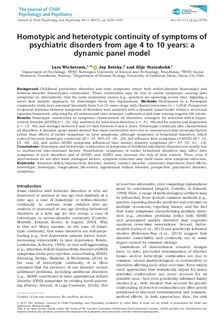| dc.contributor.author | Wichstrøm, Lars | |
| dc.contributor.author | Belsky, Jay | |
| dc.contributor.author | Steinsbekk, Silje | |
| dc.date.accessioned | 2017-12-28T13:56:35Z | |
| dc.date.available | 2017-12-28T13:56:35Z | |
| dc.date.created | 2017-06-28T08:43:22Z | |
| dc.date.issued | 2017 | |
| dc.identifier.citation | Journal of Child Psychology and Psychiatry. 2017, 58 (11), 1239-1247. | nb_NO |
| dc.identifier.issn | 0021-9630 | |
| dc.identifier.uri | http://hdl.handle.net/11250/2473830 | |
| dc.description.abstract | Background
Childhood psychiatric disorders and their symptoms evince both within-disorder (homotypic) and between-disorder (heterotypic) continuities. These continuities may be due to earlier symptoms causing later symptoms or, alternatively, that the same (unknown) causes (e.g., genetics) are operating across time. Applying a novel data analytic approach, we disentangle these two explanations. Methods
Participants in a Norwegian community study were assessed biennially from 4 to 10 years of age with clinical interviews (n = 1,042). Prospective reciprocal relations between symptoms of disorders were analyzed with a dynamic panel model within a structural equation framework, adjusting for all unmeasured time-invariant confounders and time-varying negative life-events. Results
Homotypic continuities in symptoms characterized all disorders; strongest for attention-deficit/hyperactivity disorder (ADHD) (r = .32–.62), moderate for behavioral disorders (r = .31–.48) and for anxiety and depression (r = .15–.40), and stronger between 8 and 10 than between 4 and 6 years. Heterotypic continuity also characterized all disorders. A dynamic panel model showed that most continuities were due to unmeasured time-invariant factors rather than effects of earlier symptoms on later symptoms, although symptoms of behavioral disorders, which evinced two-year homotypic continuity (B = .14, 95% CI: .04, .25), did influence later symptoms of ADHD (B = .13, CI: .03, .23), and earlier ADHD symptoms influenced later anxiety disorder symptoms (B = .07, CI: .01, .12). Conclusions
Homotypic and heterotypic continuities of symptoms of childhood psychiatric disorders are mostly due to unobserved time-invariant factors. Nonetheless, symptoms of earlier behavioral disorders may affect later symptoms of such disorders and of ADHD, and ADHD may increase the risk of later anxiety. Thus, even if interventions do not alter basic etiological factors, symptom reduction may itself cause later symptom reduction. | nb_NO |
| dc.language.iso | eng | nb_NO |
| dc.publisher | Wiley | nb_NO |
| dc.relation.uri | http://onlinelibrary.wiley.com/doi/10.1111/jcpp.12754/full | |
| dc.rights | Navngivelse-Ikkekommersiell 4.0 Internasjonal | * |
| dc.rights.uri | http://creativecommons.org/licenses/by-nc/4.0/deed.no | * |
| dc.title | Homotypic and heterotypic continuity of symptoms of psychiatric disorders from age 4 to 10 years: a dynamic panel model | nb_NO |
| dc.type | Journal article | nb_NO |
| dc.type | Peer reviewed | nb_NO |
| dc.description.version | publishedVersion | nb_NO |
| dc.source.pagenumber | 1239-1247 | nb_NO |
| dc.source.volume | 58 | nb_NO |
| dc.source.journal | Journal of Child Psychology and Psychiatry and Allied Disciplines | nb_NO |
| dc.source.issue | 11 | nb_NO |
| dc.identifier.doi | 10.1111/jcpp.12754 | |
| dc.identifier.cristin | 1479345 | |
| dc.relation.project | Norges forskningsråd: 228685 | nb_NO |
| dc.description.localcode | © 2017 The Authors. Journal of Child Psychology and Psychiatry published by John Wiley & Sons Ltd on behalf of Association for Child and Adolescent Mental Health. This is an open access article under the terms of the Creative Commons Attribution-NonCommercial License, which permits use, distribution and reproduction in any medium, provided the original work is properly cited and is not used for commercial purposes. | nb_NO |
| cristin.unitcode | 194,67,40,0 | |
| cristin.unitname | Institutt for psykologi | |
| cristin.ispublished | true | |
| cristin.fulltext | original | |
| cristin.qualitycode | 2 | |

